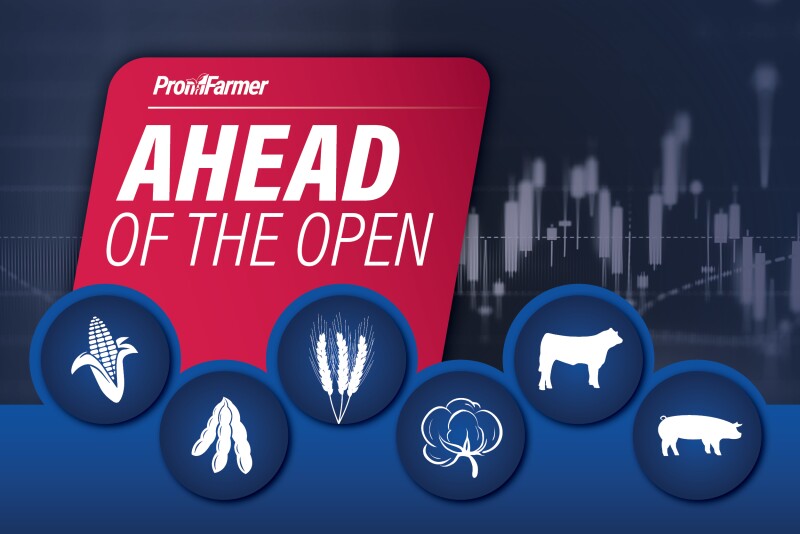GRAIN CALLS
Corn: 1 cent lower to 1 cent higher.
Soybeans: Steady to 2 cents lower.
Wheat: 1 cent lower to 1 cent higher.
GENERAL COMMENTS: Corn, soybeans and wheat each opened lower overnight but have since bounced to near unchanged. The market remains keyed in on trade, susceptible to any new developments on that front. Outside markets are mixed this morning as front-month crude oil futures are modestly higher on corrective strength while the U.S. dollar index is around 150 points higher.
USDA reported daily sales of 365,000 MT of corn for delivery to Mexico during the 2024-25 marketing year.
President Donald Trump on Sunday said the tariffs will apply to the metal imports from all countries. He didn’t specify when the duties would take effect. This marks a significant escalation in his trade policy. These new tariffs appear to be in addition to existing duties on metals from certain countries. Trump also plans to announce “reciprocal tariffs” later in the week, likely on Tuesday or Wednesday. These reciprocal tariffs would match duties imposed by other countries on U.S. goods.
China’s tariffs on $14 billion worth of U.S. exports are set to take effect today. Beijing’s retaliatory duties target U.S. manufacturing and energy sectors, which could hit Republican-leaning states hardest, according to analysts. Brazilian officials are analyzing sectors that could be impacted by U.S. tariffs and weighing countermeasures. The measures under consideration include raising tariffs, suspending the ex-tariff regime that temporarily lowers import taxes and strengthening trade ties with other BRICS nations, particularly China, Russia and India. Of note: Brazil currently imposes an 18% tariff on ethanol imports from U.S., while the U.S. does not impose any tariffs on ethanol imports from Brazil. On Saturday, Canada’s Trade Minister Mary Ng met with EU officials in Brussels to deepen economic ties between Canada and the European Union. The visit is part of Canada’s broader effort to strengthen partnerships beyond the U.S., particularly as both regions face trade challenges. Meanwhile, the European Union is exploring a proposal to reduce tariffs on U.S. car imports from the current 10% to a rate closer to the 2.5% imposed by the U.S. on European vehicles.
Some locally significant rain fell in northern Buenos Aires and far southern Santa Fe, Argentina, during the weekend. Argentina is forecast to receive more rains this week, with forecast models indicating greater amounts than on Friday, especially through central areas of the country. Center-west and some southern areas of Brazil will get frequent shower and thunderstorm activity over the next two weeks. That will benefit dry areas in far southern Brazil but will keep soybean harvest and safrinha corn planting delayed in central areas.
CORN: March corn futures gapped lower overnight but has since rebounded. Initial resistance stands at $4.88 3/4, the 10-day moving average, which is solidly backed by $4.95. Support comes in at $4.83 1/4 then $4.76 3/4.
SOYBEANS: March soybean futures saw action on either side of unchanged overnight. Bulls are looking to overcome psychological $10.00 resistance before challenging resistance at $10.60 1/2.
WHEAT: March SRW futures saw modest strength overnight. Bulls are looking to challenge initial resistance at $5.87 1/2 before tackling Friday’s high of $5.92 1/2. Support comes in at $5.77 then the 10-day moving average at $5.72 on a reversal lower.
LIVESTOCK CALLS
CATTLE: Choppy/lower.
HOGS: Choppy/lower.
CATTLE: Live cattle futures and feeders are expected to open with a mostly weaker tone, driven by continued long liquidation from funds. Cash cattle prices fell from the prior week’s record, but the cash market has held up better than futures. That has made the discount that futures hold to cash rather wide, which could support price action. Wholesale beef prices have fallen in tandem with the cash and futures market. On Friday, Choice cutout fell another $2.11 to $321.87 while Select sunk $1.87 to $312.90.
HOGS: Lean hog futures are expected to open with a mostly weaker tone, driven by technical selling pressure. April lean hog futures are in the upper end of the recent range and have struggled to see followthrough buying the past couple of sessions. Rising cash prices could help push futures higher though, as the CME lean hog index is up another 34 cents to $85.39 as of Feb. 6. The index is now nearly $5.00 off from its early January seasonal low. Pork cutout continues to make new highs as well, rising $1.36 Friday to $97.00, driven by strength in bellies.

